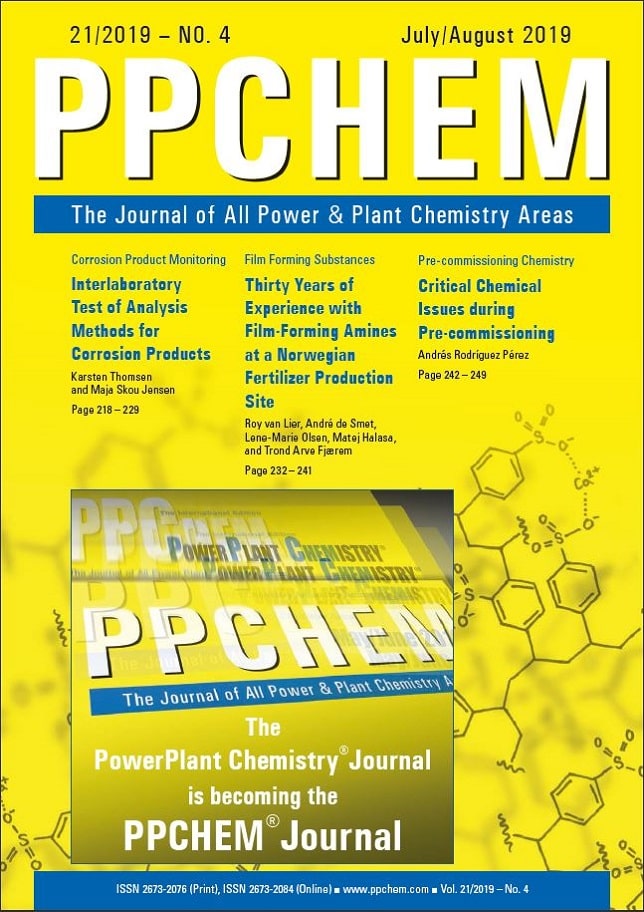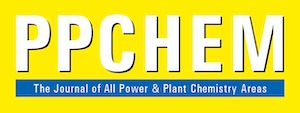
For members only
ABSTRACTS
An Interlaboratory Test of Analysis Methods for Corrosion Products
Karsten Thomsen and Maja Skou Jensen
This report describes the outcome of an interlaboratory comparison of analysis methods for iron among a group of laboratories in the power and heat industry. The samples sent out to the laboratories were real samples of feedwater and district heating water that had an inherent inhomogeneity due to the particulate nature of the corrosion products. The analysis methods compared were the standard methods based on spectrophotometry and inductively coupled plasma spectroscopy as well as analysis of filtered material on a 0.45 μm membrane filter. The filtered material from a 1 L sample was digested and dissolved to a 50 mL final sample volume, which gave a concentration factor of 20, enhancing the sensitivity of the method relative to the others. The purpose of the interlaboratory comparison was twofold: to qualify the filter method to be recommended for corrosion product analysis by the International Association for the Properties of Water and Steam in a Technical Guidance Document, and to give the laboratories an opportunity to test their methods on realistic samples against a group of other professional laboratories. For accredited laboratories, proficiency testing like this is a well-known and prescribed means of quality control and often supplements the internal quality control nicely.
Although measures had been taken to minimize the heterogeneity of the samples, the district heating samples turned out to be not even close to homogeneous. By assuming a log-normal distribution and independent results of the double determinations from each laboratory, the inhomogeneity of the samples could be handled, and the performance of the laboratories compared. The comparison shows that the reproducibility of the filter method matches the reference methods, and that both feedwater and district heating water samples fit nicely to the log-normal distribution. The results indicate that the filter method is reproducible when transferred from one laboratory to another.
PowerPlant Chemistry 2019, 21(4), 218–229
For Members only
Thirty Years of Experience with Film-Forming Amines at a Norwegian Fertilizer Production Site
Roy van Lier, André de Smet, Lene-Marie Olsen, Matej Halasa, and Trond Arve Fjærem
In Glomfjord, Norway, above the Arctic Circle, Yara produces some 400 000 t (100 % equivalent) per year of nitric acid in two older units. All of the acid is used in downstream plants on site to produce a range of fertilizer grades.
The Glomfjord site has been of great importance both to the pioneering of ammonia and nitric acid synthesis technology and to the history of Norsk Hydro, which eventually divested its fertilizer activities as Yara International. It is also a location with some of the longest operational experience with film-forming amines for industrial steam system treatment, certainly in relation to nitric acid production.
The present paper first provides background information on the Glomfjord site. Steam generation in nitric acid plants in general is then succinctly explained. Yara’s operational experience is subsequently elaborated in the context of the specificities of the Glomfjord application, and of filming amine and water chemistry in the Nordic countries. This includes analysis of a possibly unique case of fouling and damage that illustrates the importance of adequate boiler feedwater quality, regardless of the chemical treatment program in place.
PowerPlant Chemistry 2019, 21(4), 232–241
For Members only
Critical Chemical Issues during Pre-commissioning
Andrés Rodríguez Pérez
Most cases of severe corrosion and consequent failure in the commercial operation of water-steam cycle and boiler systems are initiated during the first stages of a project, frequently because of a lack of preservation, an absence of regular inspections, inadequate water quality for pressure tests and a lack of understanding of corrosion processes by many of the parties involved.
Selecting an appropriate pre-commissioning program control will mitigate the risk of corrosion during the progression of the project, and subsequently, minimize potential failures upon commissioning.
Putting together an effective pre-commissioning strategy requires a great deal of coordination among different departments, the integration of practical lessons learned and great common effort throughout the project. Even engineers involved in the first stages need to retain responsibility for keeping a long-term vision for the success of the final results.
PowerPlant Chemistry 2019, 21(4), 242–249


